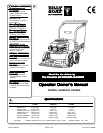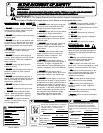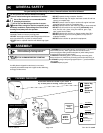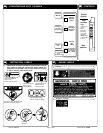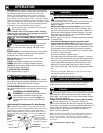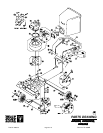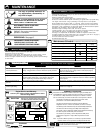
Part No. 890310 Form No. F010396B
Page 5 of 8
Nozzle Height Fine Adjustment For Hard Surface
Use: Optimum nozzle height is 1/2" (12.7mm) above ground
with engine not running. To adjust height, loosen screws (item 37),
on quad plate. Prop front of nozzle up 1.0" (25.4mm) above
ground. Keeping wheels on ground, re-tighten screws (item 37).
Recheck and fine adjust to obtain 1/2" (12.7mm) at nozzle front
(see fig 1).
Adjustment
Lowers
Nozzle
Rod In
First Hole
Adjustment
Raises Nozzle
(fig. 1)
PUT OIL IN ENGINE BEFORE STARTING
ENGINE: See engine manufacturer’s instructions
for type and amount of oil and gasoline used.
Engine must be level when checking and filling oil and
gasoline.
ENGINE SPEED: Controlled by throttle lever on the handle.
Under normal conditions, operate at minimum throttle to
accomplish your current cleaning task.
FUEL VALVE: Move fuel valve to "ON" position (when
provided on engine).
CHOKE: Operated with throttle control (Honda only).
PRIMER: Push primer on Briggs & Stratton Engines.
THROTTLE: Move remote throttle control to fast position.
Pull starting rope to start engine.
IF YOUR UNIT FAILS TO START:
See Troubleshooting on page 8.
VACUUM NOZZLE HEIGHT ADJUSTMENT: is raised
and lowered by pushing slightly downward on handle and
pulling ht. adj. rod(Item 23) at left side of handle.
FOR MAXIMUM PICKUP: Adjust nozzle close to debris, but
without blocking airflow into the nozzle.
NOTE
: Never bury nozzle
into debris.
CLEARING A CLOGGED NOZZLE
& EXHAUST: Turn engine off and wait for impeller to
stop completely and disconnect spark plug wire.
Wearing durable gloves, remove clog. Danger, the
clog may contain sharp materials. Reconnect spark
plug wire.
Item 37 Ref. Securely
Tighten, position slots
toward unit. Can be
reversed to provide better
hole alignment if required.
Note: Frequently empty debris to prevent bag overloading with
more weight than you can lift.
An optional bag and dust cover is available for use where debris will
be vacuumed in dusty conditions (see Optional Accessories
shown on page 1).
DO NOT place bag on or near hot surface, such as engine.
Run engine at 1/2 throttle for first 1/2 hour to condition new
bag. Your new bag requires a break-in period to condition the
pores of the material against premature blockage. The entire
bag surface serves as a filter, and must be able to breath to
have good vacuum performance.
Be sure engine has come to a complete stop before removing
or emptying bag.
This vacuum is designed for picking up trash, organic
material and other similar debris
(see Safety Warnings page 2 & 3).
However, many vacuums are used where dust is mixed with
trash. Your unit can intermittently vacuum in dusty areas. Dust
is the greatest cause of lost vacuum performance. However,
following these rules will help maintain your machine's ability
to vacuum in dusty conditions:
•Run machine at idle to quarter throttle.
•The debris bag must be cleaned more frequently. A vacuum
with a clean, pillow soft bag will have good pickup performance.
One with a dirty, tight bag will have poor pickup performance.
If dirty, empty debris and vigorously shake bag free-of-dust.
•Machine or pressure-wash debris bag if normal cleaning
does not fully clean bag. Bag should be thoroughly dry before
use.
Having one or more spare debris bags is a good way to reduce down
time while dirty bags are being cleaned.
•DO NOT leave debris in bag while in storage.
Debris bags are normal replaceable wear items.
Using two people to lift machine is recommended. Lift holding the
handle and front of nozzle. Secure in place during transport.
Never store engine indoors or in enclosed poorly ventilated
areas with fuel in tank, where fuel fumes may reach an open
flame, spark or pilot light, as on a furnace, water heater, clothes
dryer or other gas appliance.
If engine is to be unused for 30 days or more, prepare as follows:
Be sure engine is cool. Do not smoke. Remove all
gasoline from carburetor and fuel tank to prevent gum deposits
from forming on these parts and causing possible malfunction of
engine. Drain fuel outdoors, into an approved container, away
from open flame. Run engine until fuel tank is empty and
engine runs out of gasoline.
Do not store with debris in bag.
NOTE: Fuel stabilizer (such as Sta-Bil) is an acceptable alternative in minimizing
the formation of fuel gum deposits during storage. Add stabilizer to gasoline in
fuel tank or storage container. Always follow mix ratio found on stabilizer
container. Run engine at least 10 min. after adding stabilizer to allow it to reach
the carburetor.
OPERATION
1616
1616
16
Inspect machine work area and machine before operating.
Make sure that all operators of this equipment are trained in
general machine use and safety.
Like all mechanical tools, reasonable care must be used
when operating machine.
INTENDED USE: This machine is designed for vacuuming leaves,
grass clippings and other types of organic litter. Debris mixed with
cans, bottles and small amounts of sand can be vacuumed;
however, it is not this machine's primary purpose. Vacuuming
cans, bottles and sand will affect the longevity of your machine.
Do not operate if excessive vibration occurs. If excessive vibration
occurs, shut engine off immediately and check for damaged or worn
impeller, loose impeller bolt, loose impeller key, loose engine or lodged
foreign objects. Note: See parts list for proper impeller bolt torque
specifications. (See trouble shooting section on page 8).
STARTING
16.116.1
16.116.1
16.1
VACUUMING OPERATION
16.216.2
16.216.2
16.2
DEBRIS BAG
HANDLING & TRANSPORTING:
STORAGE
16.316.3
16.316.3
16.3
16.416.4
16.416.4
16.4
16.516.5
16.516.5
16.5



